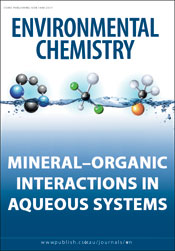
Environmental Chemistry
Volume 12 Number 1 2015
RESEARCH FRONT: Mineral–Organic Interactions in Aqueous Systems
EN14043Ligand- and oxygen-isotope-exchange pathways of geochemical interest
Environmental context. Most chemical processes in water are either ligand- or electron-exchange reactions. Here the general reactivity trends for ligand-exchange reactions in aqueous solutions are reviewed and it is shown that simple rules dominate the chemistry. These simple rules shed light on most molecular processes in water, including the uptake and degradation of pesticides, the sequestration of toxic metals and the corrosion of minerals.
EN14045Geochemical reaction mechanism discovery from molecular simulation
Environmental context. Computational simulations are providing an increasingly useful way to isolate specific geochemical and environmental reactions and to test how important they are to the overall rate. In this review, we summarise a few ways that one can simulate a reaction and discuss each technique’s overall strengths and weaknesses. Selected case studies illustrate how these techniques have helped to improve our understanding for geochemical and environmental problems.
EN14041Oxidation of CrIII aminocarboxylate complexes by hydrous manganese oxide: products and time course behaviour
Environmental context. Oxidation of CrIII (trivalent chromium) to CrVI (hexavalent chromium) is of environmental concern because CrVI is a known mutagen and carcinogen. Our results show that hydrous manganese oxide (HMO) is capable of oxidising soluble CrIII complexed with iminodiacetic acid and nitrilotriacetic acid to CrVI at appreciable rates. CrVI production from soluble CrIII organic complexes is therefore expected to occur in natural and engineered systems that contain HMO.
EN14035FeIIaq–FeIIIoxide electron transfer and Fe exchange: effect of organic carbon
Environmental context. Concerns about carbon-driven climate change make it critical to better understand how carbon interacts with soils. We examined whether carbon compounds commonly found in soils affect the behaviour of soil iron minerals, and found that iron minerals remain dynamic and mix with the surrounding water, despite the presence of carbon in the water. Our findings suggest that both carbon and trace elements in the minerals may be more mobile and less stable than we previously thought.
EN14042Multi-elemental scanning transmission X-ray microscopy–near edge X-ray absorption fine structure spectroscopy assessment of organo–mineral associations in soils from reduced environments
Environmental context. Organo–mineral associations represent a fundamental process for stabilising organic carbon in soils. In this study, we employed scanning transmission X-ray microscopy–near edge X-ray absorption fine structure (STXM-NEXAFS) spectroscopy at C, Al and Si K-edges as well as Ca and Fe L-edges to conduct submicrometre-level investigations of the associations of C with mineral components in soils from reduced environments. This study provides the first insights into organo–mineral associations in reduced environments and shows progress towards examining, at the submicrometre level, compositional chemistry and associative interactions between organic matter and soil mineral components.
EN14065Adsorption of novel insensitive munitions compounds at clay mineral and metal oxide surfaces
Environmental context. Insensitive munitions compounds are increasingly used in the manufacture of military energetic materials because of their lower unintentional explosion risk during transport and handling. The current study was designed to better resolve the environmental chemistry of two of these insensitive munitions compounds. In particular, we investigated the solid–solution partitioning that occurs when aqueous solutions containing dissolved unexploded ordinances come into contact with soil mineral media.



